#Bnha 335
Text

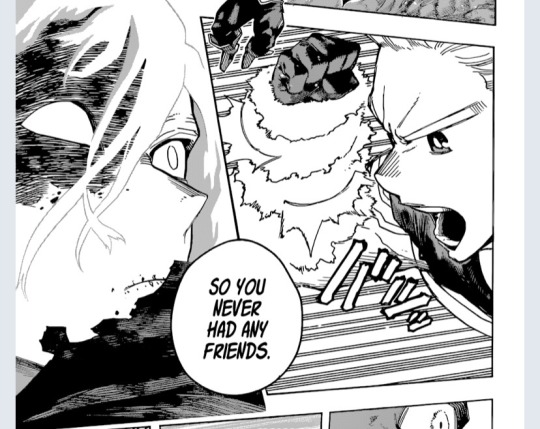

An unexpected team up
#bnha 360#mha 360#togata mirio#all for one#tomura shigaraki#dabi#touya todoroki#mha 335#bnha 335#my hero academia
273 notes
·
View notes
Note
What his jeans does dabi have with AFO? There’s nothing there besides Dabi was part of the LOV and AFO was in the background. Like there’s nothing personal there for anyone to have any interest in seeing dabi do anything towards AFO
Read chapter 350. Then read the traitor reveal chapters and pay attention to how the conversation between AFO and Toya bookends the reveal (335 and 337). In other words, the story of how AFO took advantage of a family and destroyed them is framed by AFO & Toya. Finally, notice that AFO insults Toya, calling him by his real first name, saying Toya is friendless, and referring to him as a fizzled lighter to be tossed aside. AFO is going directly for Toya’s biggest weakness to manipulate him and prevent him from running off on his own.
#bnha spoilers#mha spoilers#toya todoroki#Dabi#afo#all for one#mha 350#bnha 350#mha 335#bnha 335#mha 337#bnha 337
7 notes
·
View notes
Text
It's funny going through the Hagakure tag and seeing all the stuff and memes about her being the traitor
#Hagakure tooru#IM HAPPY MY BABY BEAT THE ALLEGATIONS 💪🏽💪🏽💪🏽💪🏽#RAAAAAAH🦅🦅🦅🦅🔥🔥🔥#bnha#u.a traitor#u.a traitor theory#ua traitor#by favorite character beat the allegations but unfortunately my 2nd fav could not😞#never disrespect my queen like that again#y'all are quirkist✋🏽😒#bnha 335#bnha chapter 335
13 notes
·
View notes
Photo


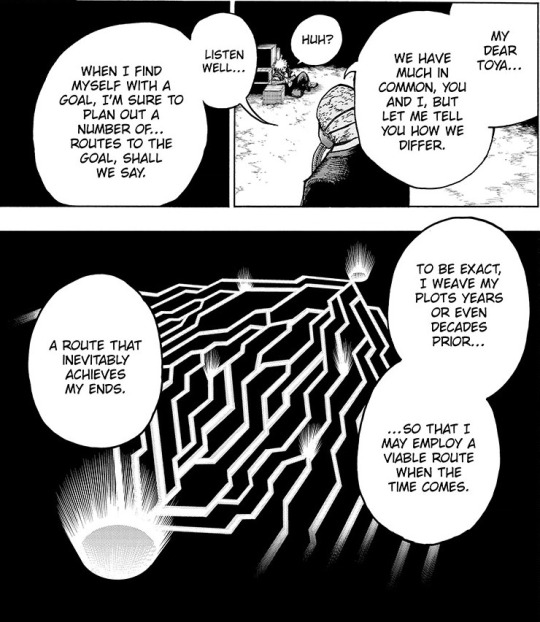
9 notes
·
View notes
Text
So a while ago, when 335 came out, I made this post talking about how it looked like Deku had gotten taller than Bakugo after a year. I got a lot of opinions on that post, and I’ve just been waiting for the boys to stand next to each other on panel again.
My prayers have finally been answered
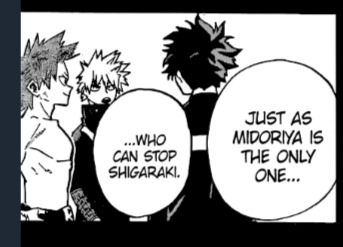
I don’t know what else to say guys, Deku’s fucking taller. Bakugo is looking slightly up and Deku’s head is tilted down while he addresses him. Short king Bakugo is official. We did it y’all

#bnha spoilers#mha spoilers#bnha 351#the fact that it’s the SAME SCENE from 335 is icing on the cake#I will die on this hill#bakudeku#bkdk#katsuizu#katsudeku#katsuki bakugo#bakugo katsuki#deku midoriya#izuku midoriya#midoriya izuku#we stan one short king#and one slightly bigger short king
192 notes
·
View notes
Text
On Heteromorphs and Heteromorphobia (Arc XIX - XXI-a, Star & Stripe to Final War-a)
Okay, so, I had intended to make one last post to cover through the hospital attack, but as my work week kept me very busy, the write-up on the hospital stuff itself is not finished yet. However, when I checked the word count on the S&S arc up through the end of what I had on the hospital--somewhat shorthanded notes on the first two chapters that would need considerable fleshing out, and bupkis on the second two chapters--I found it was already at seven thousand words, far over the four to five thousand mark I've been aiming for per post in this series. So, this week's somewhat shorter post covers from where we left off up through Chapter 369, the last chapter before the hospital material starts. Hit the jump!
The Star and Stripe Arc (Chapters 329-334)
Chapter 329:
AFO explicitly pins the blame for Spinner’s difficult life on his being a heteromorph and notes that many in the shadows empathize with his cause, leading to an explanation for the Spinner fanboys from 318: Spinner is becoming the face of a movement!
Much of this stirring up of heteromorphs around the country is being done by the remnants of the PLF, particularly Spinner’s PLF advisors, who have been putting up posters about Spinner being the voice of discontented and mistreated heteromorphs, posters that also suggest a coming reckoning in grand language steeped in cult mentality: gather soon, liberation, fruition, neutrality is a sin.
(And not just Spinner! The line about neutrality being a sin is from a set of posters about the tragedy of Toga Himiko, picking back up the tack Curious had wanted to take in using Toga’s story to realize Liberation.[1] It’s unclear whether Spinner’s advisors are also putting up the Togaganda or whether that’s being handled by some of the other remnants we’ll see later.)
The beauty of this is that once heteromorphs are stirred up enough, they’ll be gathering comrades and spreading the word of their own volition, even to those with no contact with the PLF. Of course, the people ultimately behind this are Skeptic and AFO, neither of them heteromorphs, and both with transparent ulterior motivations, though Skeptic at least is still holding to Re-Destro’s ideology of Liberation and likely does view the subsequent mob activity as helpful to heteromorphs themselves, as opposed to the mere means to his own end of becoming the Demon King AFO has in mind.
[1] And which Skeptic had once scoffed at, feeling Toga a poorly suited choice for that sort of mythologizing. I wonder if he’s just gotten more desperate or if he’s acceded that Toga’s just fine for bringing about Liberation provided that it’s Liberation à la Shigaraki Tomura?
But how about Spinner himself? Well, he looks unconvinced, to say the least. More on this later, when he gets more context on what the reader is already seeing.
Chapter 333:
There’s one lone heteromorph outside of Agpar in Star’s crew. He’s not a very extreme one—tall but not inhumanly so, with a snouty facial structure and long, upward-pointing ears—but he is still the only heteromorph I’ve yet seen in the default masses of a uniformed group of military-types. Like, BNHA’s masses of riot squad type cops are all baseline, the guards at Tartarus were all baseline, the probably-JSDF guys in the movie are baseline, and so forth. These folks are often wearing helmets, of course, so there might be some minor divergences scattered amongst them, but there’s only so much divergence that a helmet and full-coverage uniform will hide! Odd skin tones, yes, unusual eyes, sure, but not protruding facial features or anything other than very small horns, and divergent body plans are right out.
The U.A. Traitor Arc (Chapters 335-342)
Chapter 335:
All Might very conspicuously omits Spinner from the list of threats facing the hero side. In the moment, it reads like All Might doesn’t view Spinner as a threat. And sure, why would one random, weak-quirked lizard guy constitute a threat worth mentioning, right? Later on, we’ll find out that the heroes were trying to keep Kurogiri’s location on the down-low, so this omission may simply be an effort to avoid having to discuss the target of the mob that’s brewing by not bringing up the mob to begin with.
While I assume that’s Horikoshi’s reasoning for this scene playing the way it does, I do think there are some questions raised by later chapters that imply that heroes are underestimating the situation quite severely. To wit, it’s already known that the obfuscation has failed and an attack on the hospital is coming—even someone as removed from villain goings-on as the Ordinary Woman had heard about it, news which she relayed to Shouji. I can’t believe that Hawks and company wouldn’t have intel to match that, if only via also learning of the attack from Josei-san.
If the heroes already know the hospital assault is coming, though, why on earth is it so under-defended? They can’t possibly be running the risk that an attack set to be led by a member of the League of Villains (as they might presume to be the case thanks to all the posters everywhere!) would choose to target the hospital at random, or that it’s just some kind of generic protest that won’t be trying to breach the walls—surely they must know the mob is coming for Kurogiri? But then why such paltry numbers of defenders?
I can only assume that the heroes badly, badly underestimated how deep heteromorphic anger and pain ran, and thus equally badly underestimated how many people would show up for the attack. All Might, being part of that central group of planners, is also one of the people being proven deeply ignorant about, and dismissive of, both the suffering endured and the danger presented by the heteromorphs he knows are coming.
Shouji immediately picks up on the omission and indirectly challenges it when he says, “It’s safe to assume the list goes on,” which All Might deflects with, “Yes. They will likely amass more allies,” still not talking about who those allies are going to be. May I say, then, that if there’s any extent to which All Might doesn’t want to talk about this because he doesn’t want to field questions about why a mob of civilian heteromorphs might choose to ally themselves with the League of Villains, it doesn’t reflect particularly well on him.
Chapter 341:
Skeptic gives us the line that ties together every single crowd scene demographic we’ve seen over the course of the entire manga:

My vindication, let me show you it.
There are a few subtly different ways you could read this, so I checked with my translator sis-in-law about her take on it. She said that what Skeptic’s implying here in the Japanese is that, taken as a whole, a telling proportion of criminals designated as “Villains” are heteromorphs. That is, by inference, heteromorphs are overrepresented in Villain-level criminality.
So why might that be? Well, look back at everything I’ve said through this whole essay to date:
o Discrimination runs rampant in this society, from minor microaggressions perpetrated by otherwise heroic characters all the way up through dedicated, violent hate groups. Those facing discrimination may have reduced opportunity, thereby pushing them into harder choices, which may make criminality more difficult to avoid.
o Heteromorphs make up a larger proportion of the population in seedy, rougher areas, suggesting they’re probably lower income, proportionally, than non-heteromorphs. Lower income means the necessity of facing harder choices, as above.
o The very nature of heteromorphism leading to the laws being applied to them more strictly—for example, if a heteromorph gets into a fist fight with an emitter, the heteromorph’s very body being a part of their quirk may make it more likely for them to be charged as Villains for illegal quirk use than the emitter. (Think of something like Mandalay not thinking of Spinner as having used his quirk during the training camp, but him being categorized as a villain regardless.)
o Bias against heteromorphs leading to the laws being applied to them more strictly. If the person in charge of deciding how prosecutors are going to handle an accusation against you, and they just reflexively don’t like the look of your face, or are even openly heteromorphobic, of course you’re more likely to get treated like a Villain than someone a baseline prosecutor more readily sees the humanity in. This problem in particular will self-perpetuate—more heteromorphs being prosecuted as villains means more cops begin to perceive them as inherently more prone to villainy.
Skeptic doesn’t say outright that criminals who are designated as Villains are more frequently heteromorphs compared to baseline types who committed equivalent crimes, but it sure is easy to read as an implication! After all, why else would he need to specify “Villain-designated criminals” as opposed to simply one or the other? If all he meant is that heteromorphs make up a larger demographic percentage of criminals and/or of Villains than they do a demographic percentage in the general population, he could just say that. It would still imply that there’s some unjust reason for that, but “villain-designated criminals” means that he’s suggesting that the numbers are out-of-whack specifically at that intersection, the place where “criminal” gets modified to “Villain.”
He goes on to say, “No matter how hard heroes and the government have tried to illuminate our society, the light can’t reach every dark corner. Plenty of heteromorphs hold deep grudges against the so-called heroes,” referencing ideas of light and illumination that will come up again in the hospital attack.
Most literally, we could say this refers to rural discrimination, far away from the advanced, “integrated” cities, and the way heroes cluster around those urban areas because that’s where the money and fame are at. But I think it can cover my points above, as well—think back to the purse snatcher from the first chapter, who got run down by a whole passel of heroes and then paraded around in front of cameras in a muzzle, like an animal, for—stealing a purse. Called “pure evil” by Kamui Woods for—blocking traffic? Gosh, I wonder if that guy might hold a grudge against heroes?
Spinner articulates what he was almost certainly feeling back when AFO was first talking him up in 329: that he’s average dude, not some messiah, that he’s only here for Shigaraki, not to serve a great cause. Still, Skeptic says, the common people are waiting for him; he’ll be the one to pull a trigger Re-Destro no longer can. The very perception that he’s someone average, Just Another Heteromorph Like Us That Got Tired Of It, is what makes him such an inspiring figure.
Chapter 342:
All the students in the little montage bidding farewell to people at U.A. are those whose parents we’ve met, all also there in the scene, with one conspicuous exception: Shouji is talking to the Ordinary Woman, who is most certainly not any relative of his. I grow more annoyed by her lack of a name by the chapter.
This chapter features one of the manga’s starkest examples of the dehumanization of villains: Uraraka’s dialogue about how it had never even crossed her mind to consider Toga Himiko’s circumstances and beliefs. Toga is, of course, a seventeen-year-old girl, only a year and a half older than Uraraka herself, and one who first went on the run at fifteen. They’re so close in age, even met over the summer, yet Uraraka only realized—truly understood—that Toga was “a person too” when she saw Toga crying.
Further, when confronted when this realization, Uraraka’s instinct is to try to quash it, to assume that even thinking this way makes her some kind of villain-apologist freak, so she has to banish those thoughts by going out and staring at scenes of immensely traumatic destruction to remind herself of what Toga had a hand in and thereby banish her human compassion.
This is not framed as being about heteromorphs, but just last chapter, it was laid out for the reader in black and white that heteromorphs make up an outsized proportion of “Villain-designated criminals.” Thus, in turn, they’re proportionally more likely than any other group to be subject to the dehumanization faced by villains, and here we see just how extreme that social conditioning is even in a nice, empathetic, thoughtful girl like Uraraka.
The Final War Arc (Chapters 343-369, for now)
Chapter 345:
Geten’s #3, a heteromorph right on the border between resembling an animal and just being weird-shaped (if anything, he looks more like a heteromorph based on a Pokémon), calls the heroes Mammonists, a term referring to followers of Mammon, a personification of wealth/lust for wealth.[2] Professional Heroism as HeroAca’s Japan practices it is an inherently capitalistic endeavor. It’s wildly commercialized, rewards competition before cooperation, and dehumanizes the human assets that keep it going, hero and villain alike. Calling heroes Mammonists, therefore, echoes Stain’s accusations, and recalls Mount Lady’s grin way back in the first chapter when she stole the “kill” from Kamui Woods, all in the interest of fame, benefits, and government pay.
[2] In the Japanese, haikin shugisha, literally “money-worshipper”; jisho even gives Mammonist as a direct translation.
I want to reiterate a few points I’ve talked about before, as well as add a few new considerations, to get at what I think is telling about not!Greninja’s Mammonist accusation as it relates to heteromorphobia:
o Mount Lady’s bonus chapter established that more rural areas see less heroism. This impacts heteromorphs like Shouji and Spinner both because there’s no one around who’s both willing and able to save them from the abuses they suffer[3] and because there are no heteromorphic heroes around to serve as role models.
o Tomura’s Chapter 237 flashback established that rougher areas are slower to see hero agencies established in them—the men shortly to be murdered by Tenko complain about a bunch of new hero agencies being built in the area lately. That’s over a decade prior to canon, sure, but many long years more since the establishment of professional heroism!
o I’ve demonstrated that higher concentrations of heteromorphs in an area can serve as a visual shorthand for it being a poorer, rougher place to live.
o A hero’s ranking depends on incident resolution, public approval, and social contribution—all things that disadvantage those who work in rural areas.
o Two characters in Class 1-A were admitted as “recommendation” students, i.e. those who can take smaller-group versions of the exams, as well as getting the benefit of an interview portion. Those two characters are Momo and Shouto—both baseline, both powerful, both wealthy. Does U.A. offer scholarships? Any financial aid for underprivileged students? Any programs to seek out promising youth who may not have the connections to get recommendations? Who knows! But, we sure do have a telling window on who gets small-batch exam privileges.[4]
[3] Of course, if you take Vigilantes as canon, there’s no guarantee heroes would have helped them anyway—the people attacking them were doing so with pitchforks and pesticides, after all, not quirks. That firmly puts those attacks in the category of “not a hero’s job.” But let’s give Heroes enough benefit of the doubt to assume that even a pretty materialistic one would probably not have stood by while a crowd of adults attacked a ten-year-old with farming tools unless they themselves had already been raised to such violent heteromorphobia—which, if they’re content to be working in such rural areas, odds are they were.
[4] This particular argument is, I admit, much weaker when you factor in Juzo, Tokage and Inasa, but if Horikoshi didn’t want to make some unfortunate implications about who benefits from the recommendation program, he shouldn’t have made 100% of the recommendation students in the Main Character Class baseline, powerful and wealthy.
Taken all together, it’s easy to understand why someone might accuse Heroes—especially Heroes who bust out the kind of exorbitantly expensive, last-minute constructs the heroes have just busted out—of being money-obsessed. Successful heroes live and die on commercialism, on public recognition, on their “brand,” and that structure keeps the money flowing—from the government to heroes, from civilians into the Hero industry, from heroes to the vast array of production companies supporting them on all fronts. The whole industry is a prayer wheel that turns on money.
Now, Geten’s #3 is a pretty flashy dresser himself—those pinstripes!—so whenceforth this “Mammonist” accusation? Well, I would point out that he is a heteromorph, and reiterate the story’s frequent utilization of heteromorphs to visually communicate lower income brackets. Perhaps he himself has experience with poverty, even if he’s clearly doing better for himself these days. If so, then it’s very likely that the beef that drives his embrace of Liberation ideology is that the Hero System first criminalizes public quirk use for non-heroes and then monetarily disincentivizes getting help where it’s truly needed, all while pouring money into Heroics elsewhere like a busted oil tanker spewing crude into the Gulf.
Chapter 349:
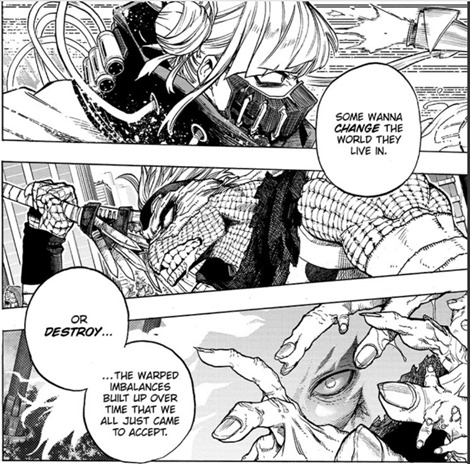
Spinner is visually suspended between the desire to change the world he lives in and the desire to destroy “the warped imbalances (…) that we all just came to accept.” He embodies both—he’s someone who once resigned himself to his warped lot in life, who came to the League because he wanted so desperately to change, because he wanted to believe that change could be brought about by only a single man, and who fell in love with the promise of destruction. Hero Society never promised him either, so he came to the only people who could.
Chapter 353:
This chapter places Spinner firmly at Central Hospital, here to retrieve Kurogiri. The group he’s leading is entirely composed of heteromorphs, including two of his three PLF advisors; this, combined with the set-up about heteromorphs looking to him and Mezo “I want to feature him in the story” Shouji’s conspicuous presence, hints at what’s about to go down at this location.
Chapter 355:
AFO’s got a snappish “fowl duo” thought about Hawks and Tokoyami—just “two birds” in the Japanese, but still dismissal of them as animals.
Of the ones we can see, AFO has exactly one vestige with tiny little horns; every other one attacking him is baseline in their general appearance and build. Not exactly beating my heteromorphobic accusations there, big guy.
Chapter 358:
ShigAFO brings up appearance and form in his monologue about how the post-Advent world is a world beyond hope of a status quo, full of disparities that lead to a lack of understanding, and thence to fear and rejection. It touches on similar themes as Nedzu’s speech back in 323, but with an ultimately fatalistic bent.
Bakugou relates this all to Deku—their past relationship, as well as Deku being brought back to U.A.—but, as we will see, the arc’s got some heavier hitting stuff in mind for talking about disparities giving rise to fear and rejection.
Chapter 363:
Mirko’s gets another self-referential animal quip that only exists in Caleb Cook’s colorful localization. The line rendered as, “If only I’d been one hop faster!” only references being one step faster in Japanese.
----------
Next time, I will finally actually cover the hospital! Hopefully it will be in a week, but it's only half-written and is, I suspect, going to require a lot more editing to strike the right balance on discussing what I think is relevant and simply complaining about how egregiously bad it is as a resolution to this whole aspect of the worldbuilding. Followers who read my posts on those chapters will likely find my bitching familiar, but this is piece is bound for AO3 eventually, so it needs to be able to stand on its own without too much reference to other posts.
In any case, it should be up in one or two weeks, depending on how busy work keeps me.
On the topic of work, and with a number of new followers around, this is probably a good time for me to point out again that I'm in a pretty tight financial situation, so if you've been enjoying this series of posts and are of a mind to throw a few bucks my way, I do have a ko-fi you can use to do so!
Thanks for reading, all!
#bnha#bnha meta#bnha worldbuilding#heteromorph discrimination plot#iguchi shuuichi#bnha spinner#plf advisors#my writing
27 notes
·
View notes
Text
Since there WILL BE QUESTIONS: All the stuff about Hagakure in the 355 tag is actually about chapter 335. Check the dates of these posts. People just mistyped the chapter number way back in November. Fun fact! You can actually see something similar if you search for bnha 366, there’s a bunch of stuff talking about 336
76 notes
·
View notes
Text

I posted 4,923 times in 2022
That's 118 more posts than 2021!
41 posts created (1%)
4,882 posts reblogged (99%)
Blogs I reblogged the most:
@pikaminari
@scream-mans-friend
@touwuya
@ging-ler
@annalyticall
I tagged 376 of my posts in 2022
#bnha - 48 posts
#mha - 42 posts
#shinkami - 26 posts
#kaminari denki - 23 posts
#my hero academia - 21 posts
#shinkami fanfic - 17 posts
#dabi - 16 posts
#denki kaminari - 16 posts
#shinso hitoshi - 15 posts
#hitoshi shinso - 9 posts
Longest Tag: 130 characters
#like all the foreshadowing and the perfect questions that all get answered and the perfect bittersweet ending and ugh i’m rambling
My Top Posts in 2022:
#5

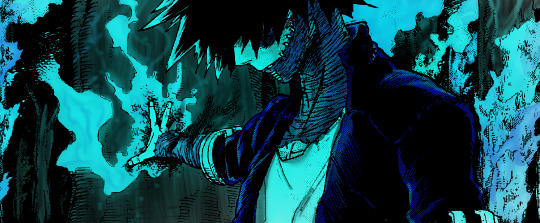
See the full post
73 notes - Posted April 3, 2022
#4
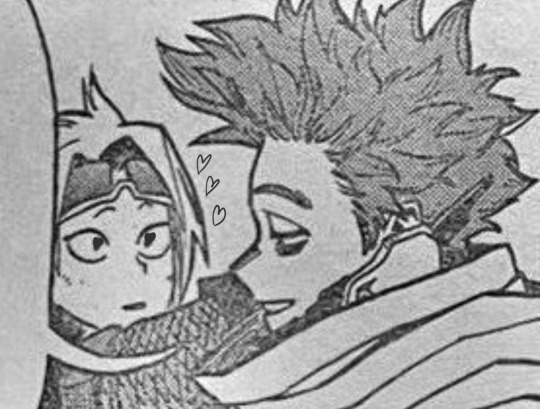
I really just wanna share this in its own post cause I just think it’s so cute
98 notes - Posted February 17, 2022
#3
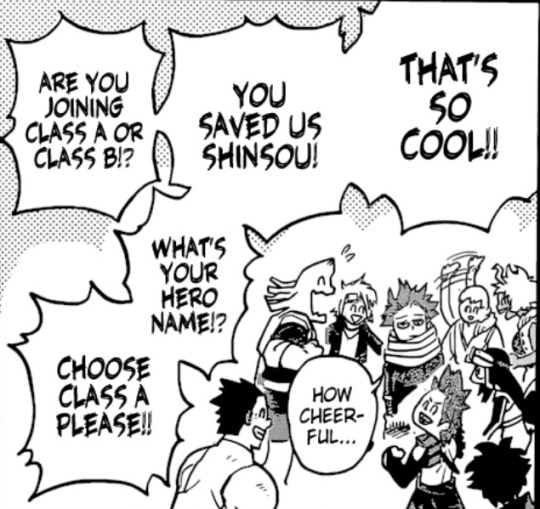
Shinso “I’m not here to make friends” Hitoshi everyone!
133 notes - Posted February 18, 2022
#2
I need a collection of high quality manga panels of Denki so I can color them please help
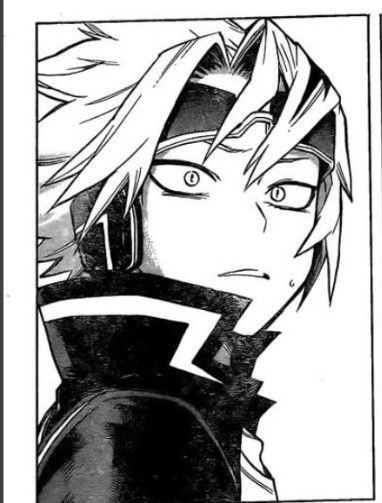

Shit like this and specifically I’m looking for the one of him standing with his pointer finger up all electrified and shit
147 notes - Posted May 1, 2022
My #1 post of 2022
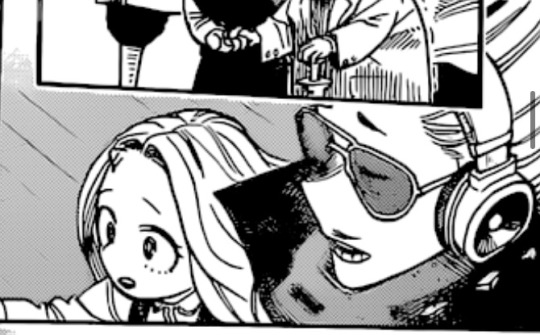
Proof that Mic is one of Eri’s dads
335 notes - Posted February 9, 2022
Get your Tumblr 2022 Year in Review →
2 notes
·
View notes
Text
bnha manga thoughts
historically speaking, american foreign involvement is.. iffy. if the cia are involved things are probably going to get worse im looking at like a good chunk of latin america and the banana wars. arguably some of the more publicized stuff helped like taiwan, south korea, germany, and japan are doing pretty well for themselves, and the financial/logistics backing for europe and now ukraine (well the ww2 stuff was pure war profiteering). and then there's inherent abuses of the us industrial military complex, tax payer money to line the pockets of weapons manufacturers and defense contractors, preying on the poor with funding from tax dollars, the rampant abuse and all the crimes that get covered, the lack of regulation in general so you have human rights abuses environmental damage military bases usually poison the surrounding areas.
332: hmm we're too early in this fight. i think some of the pilots will die.
335: holy shit if those hagakure is the spy than the conspiracy theorists got it right. i remember there was this old fan theory circa 2017? 2018? which posited hagakure was the spy because how else did someone so weak get into ua like she can turn invisible and that's it. and how narratively she hadn't done anything while everyone else how a few pages at least. at the time i thought it was a cool idea for an otherwise boring character but the lack of evidence stopped me from going all in on it. in the early arc its said? implied? that there's a spy in UA and people were able to logic and reason it down to probably being a student (i dont remember how they ruled teachers out). hagakure was suspect number 1 but there were a couple other 1 A put up.
336: oh yeah the secret forest training camp. and yeah aoyama was the other one speculated to be a spy. the other conspiracy theoriests got it right!
348: i still say mirko should have put knives on her feet.
353: did shouto magically heal dabi's chest area????
362: oh so this is what everyone was screaming about. i wonder if horikoshi would actually kill off such a popular character. hmm we shall see. on one hand we had that final coming to terms with deku and choosing to fight as well as the rain. but this also feels rather stupid for bakugou (dynamight. ah i remember people headcanoning that too). like bakugou through out has shown excellent battle sense and judgement, he makes clever plays, and he's good at taking care of himself to foil midoriya who destroys himself during battles, so to misjudge shigaraki so much is odd.
363: heart ripped to shreds, chapter title. yeah that sounds pretty dead. though i would never discount the power of anime.
364: the power of anime. though i dont get why edgeshot has to die besides for the drama. like if you think about conservation of matter a heart is only a few pounds while an adults is over 100 pounds, like he should only have to give up an arm or something (and then he can join the growing amputee club).
365: ah question answered. i love mirko. even if the shrinking number of limbs is concerning.
366: this is the story of how mirio saved the world with his fat cheeks.
370: oh shouji. he kept his mouth covered because he didn't want to freak people out. m
2 notes
·
View notes
Note
I'm hoping more for Bakugo and Deku deal with the question over the failure of hero society as a whole. I think the whole what makes a true hero part should be a question that is asked everywhere otherwise it would feel that the only characters who can be true heroes are Deku, Bakugo and Shigaraki.
Well, no that’s not what that means.
All questions will be answered through all characters at the end. All the themes will apply to everybody. Aoyama and Midoriya have similar circumstances, but it was kind of addressed more in Aoyama’s tiny backstory than it ever was with Midoriya. Despite the fact that it was what started his hero journey in the first place, it wasn’t REALLY touched on until 335 chapters in?
Shouto’s arc revolves around his family, but his arc is still very much helping him answer to himself what kind of hero he wants to be. And he did that (and will do it some more) through the actions he takes toward his brother. Just because his arc is mostly about his family, does that mean he isn’t a true hero at the end? That’s not how that works.
If Ochacko shows Toga acceptance and listens to her pain and saves her in the process, is she not considered a true hero just because it wasn’t the central theme of their arcs together?
I was just trying to say that it seems that specific issues in BNHA are being delegated to certain characters to address. Not that their issues ONLY apply to them and nobody else.
All the kids are gonna be considered true heroes at the end, just because that particular theme is more heavy in the Shigaraki and Midoriya plot line doesn’t mean it doesn’t apply to everyone else.
4 notes
·
View notes
Text

#bnha 335#mha#bnha#boko no hero academia#bnha spoilers#bnha 335 spoilers#mha 335 spoilers#mha hagakure#bnha hagakure#bnha touya#dabi todoroki
9K notes
·
View notes
Text
people already are disappointed that it’s hagakure because no one cares about her. THATS THE POINT, GUYS. she’s an excellent spy (better than hawks lmao) who managed to stay off the radar and purposefully didn’t became too close to anyone, while also not staying too distant from anyone to avoid being suspicious.
and like i talked previously, she’s probably doing it to get rid of her old quirk and get a new one from afo.
#bnha#bnha spoilers#bnha 335#like yeah I see why denki would cause more drama#but he doesn’t make sense as a spy#not with his quirk or personality#cause a spy would know that getting too close to people is not smart#kaminari became instant friends with sero and the boys#not to mention jirou
4K notes
·
View notes
Text
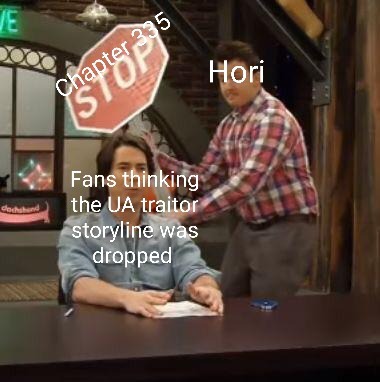
#ngl i had my money on Denki#bnha 335#bnha#bnha spoilers#ua traitor#mha#my hero academia#boku no hero academia
7K notes
·
View notes
Text

#plz my sister sent me this and I died#bnha#bnha 335#mha#mha 335#bnha spoilers#hagakure tooru#tooru hagakure#credit to @rodeisoru on twitter!!!!
6K notes
·
View notes
Text
So in this weeks chapter of bnha, Hagakure is relevant

4K notes
·
View notes
Text
hagakure the traitor ( ft. my thoughts )
no because remember the usj arc? when class 1a finally got out hagakure said she was with todoroki but todoroki said he didn’t see her anywhere

the mall incident. she suggested it. and guess who deku encountered at the mall? shigaraki.
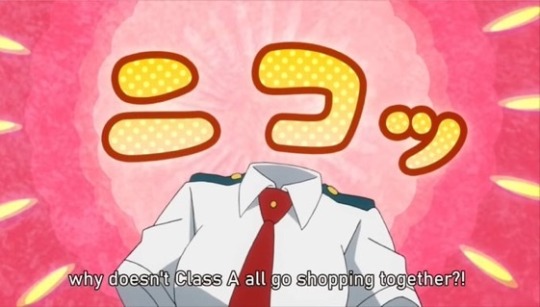
the forest camp training arc. theres a possibility she tattled abt it to the lov too
also theres a possibility that hagakure could be a nomu like kurogiri 🙂👍
all in all it all just makes sense to me that she’s the ua traitor.
#jia.txt#bnha 335#my hero academia#bnha#mha#bnha spoilers#toru hakagure#traitor hagakure#istg horikoshi when are u gonna reveal ur ao3 acc
4K notes
·
View notes